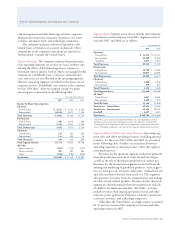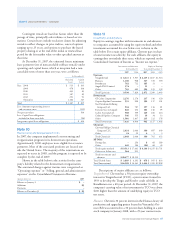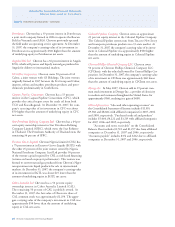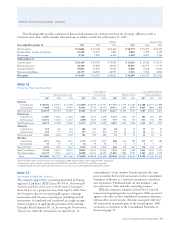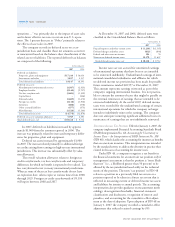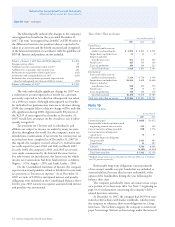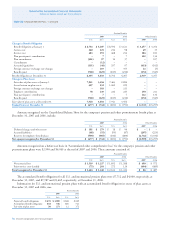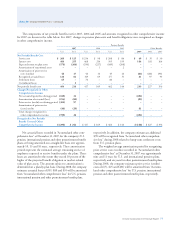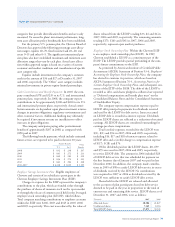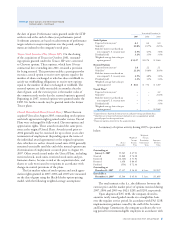Chevron 2007 Annual Report Download - page 75
Download and view the complete annual report
Please find page 75 of the 2007 Chevron annual report below. You can navigate through the pages in the report by either clicking on the pages listed below, or by using the keyword search tool below to find specific information within the annual report.
73
specific agreements may be based on the London Interbank
Offered Rate or bank prime rate. No amounts were outstand-
ing under these credit agreements during 2007 or at year-end.
At December 31, 2007 and 2006, the company classi-
fied $4,382 and $4,450, respectively, of short-term debt as
long-term. Settlement of these obligations is not expected to
require the use of working capital in 2008, as the company
has both the intent and the ability to refinance this debt on
a long-term basis.
Total long-term debt, excluding capital leases, at Decem-
ber 31, 2007, was $5,664. The company’s long-term debt
outstanding at year-end 2007 and 2006 was as follows:
At December 31
2007 2006
3.375% notes due 2008 $ 749 $ 738
5.5% notes due 2009 405 401
7.327% amortizing notes due 20141 213 213
8.625% debentures due 2032 161 199
8.625% debentures due 2031 108 199
7.5% debentures due 2043 85 198
8% debentures due 2032 81 148
9.75% debentures due 2020 57 250
8.875% debentures due 2021 46 150
8.625% debentures due 2010 30 150
3.85% notes due 2008 30 –
3.5% notes due 2007 – 1,996
7.09% notes due 2007 – 144
Medium-term notes, maturing from
2021 to 2038 (6.2%)2 64 210
Fixed interest rate notes, maturing from
2008 to 2011 (8.2%)2 27 46
Other foreign currency obligations (0.5%)2 17 23
Other long-term debt (7.4%)2 59 66
Total including debt due within one year 2,132 5,131
Debt due within one year (850) (2,176)
Reclassified from short-term debt 4,382 4,450
Total long-term debt $ 5,664 $ 7,405
1 Guarantee of ESOP debt.
2 Weighted-average interest rate at December 31, 2007.
Long-term debt of $2,132 matures as follows: 2008 – $850;
2009 – $431; 2010 – $65; 2011 – $48; 2012 – $33; and after
2012 – $705.
In 2007, $2,000 of Chevron Canada Funding Company
bonds matured. The company also redeemed early $874 of
Texaco Capital Inc. bonds, at an after-tax loss of approxi-
mately $175. In 2006, $510 in bonds were retired at maturity
and $1,700 of Unocal debt was redeemed early at a $92
before-tax gain.
FASB Statement No. 157, Fair Value Measurements (FAS 157)
In September 2006, the FASB issued FAS 157, which
became effective for the company on January 1, 2008. This
standard defines fair value, establishes a framework for mea-
suring fair value and expands disclosures about fair value
measurements. FAS 157 does not require any new fair value
measurements but applies to assets and liabilities that are
required to be recorded at fair value under other account-
ing standards. The implementation of FAS 157 did not have
a material effect on the company’s results of operations or
consolidated financial position.
FASB Staff Position FAS No. 157-1, Application of FASB
Statement No. 157 to FASB Statement No. 13 and Its Related
Interpretive Accounting Pronouncements That Address Leas-
ing Transactions (FSP 157-1) In February 2008, the FASB
issued FSP 157-1, which became effective for the company
on January 1, 2008. This FSP excludes FASB Statement
No. 13, Accounting for Leases, and its related interpretive
accounting pronouncements from the provisions of FAS 157.
Implementation of this standard did not have a material
effect on the company’s results of operations or consolidated
financial position.
FASB Staff Position FAS No. 157-2, Effective Date of FASB
Statement No. 157 (FSP 157-2) In February 2008, the FASB
issued FSP 157-2, which delays the company’s January 1,
2008, effective date of FAS 157 for all nonfinancial assets and
nonfinancial liabilities, except those recognized or disclosed
at fair value in the financial statements on a recurring basis
(at least annually), until January 1, 2009. Implementation of
this standard did not have a material effect on the company’s
results of operations or consolidated financial position.
FASB Statement No. 159, The Fair Value Option for Financial
Assets and Financial Liabilities − Including an amendment of
FASB Statement No. 115 (FAS 159) In February 2007, the
FASB issued FAS 159, which became effective for the com-
pany on January 1, 2008. This standard permits companies
to choose to measure many financial instruments and certain
other items at fair value and report unrealized gains and losses
in earnings. Such accounting is optional and is generally to
be applied instrument by instrument. The implementation
of FAS 159 did not have a material effect on the company’s
results of operations or consolidated financial position.
FASB Statement No. 141 (revised 2007), Business Combina-
tions (FAS 141-R) In December 2007, the FASB issued FAS
141-R, which will become effective for business combination
transactions having an acquisition date on or after January 1,
2009. This standard requires the acquiring entity in a business




